Anna Korhonen
Multi-Agent Design: Optimizing Agents with Better Prompts and Topologies
Feb 04, 2025Abstract:Large language models, employed as multiple agents that interact and collaborate with each other, have excelled at solving complex tasks. The agents are programmed with prompts that declare their functionality, along with the topologies that orchestrate interactions across agents. Designing prompts and topologies for multi-agent systems (MAS) is inherently complex. To automate the entire design process, we first conduct an in-depth analysis of the design space aiming to understand the factors behind building effective MAS. We reveal that prompts together with topologies play critical roles in enabling more effective MAS design. Based on the insights, we propose Multi-Agent System Search (MASS), a MAS optimization framework that efficiently exploits the complex MAS design space by interleaving its optimization stages, from local to global, from prompts to topologies, over three stages: 1) block-level (local) prompt optimization; 2) workflow topology optimization; 3) workflow-level (global) prompt optimization, where each stage is conditioned on the iteratively optimized prompts/topologies from former stages. We show that MASS-optimized multi-agent systems outperform a spectrum of existing alternatives by a substantial margin. Based on the MASS-found systems, we finally propose design principles behind building effective multi-agent systems.
A Rose by Any Other Name: LLM-Generated Explanations Are Good Proxies for Human Explanations to Collect Label Distributions on NLI
Dec 18, 2024Abstract:Disagreement in human labeling is ubiquitous, and can be captured in human judgment distributions (HJDs). Recent research has shown that explanations provide valuable information for understanding human label variation (HLV) and large language models (LLMs) can approximate HJD from a few human-provided label-explanation pairs. However, collecting explanations for every label is still time-consuming. This paper examines whether LLMs can be used to replace humans in generating explanations for approximating HJD. Specifically, we use LLMs as annotators to generate model explanations for a few given human labels. We test ways to obtain and combine these label-explanations with the goal to approximate human judgment distribution. We further compare the resulting human with model-generated explanations, and test automatic and human explanation selection. Our experiments show that LLM explanations are promising for NLI: to estimate HJD, generated explanations yield comparable results to human's when provided with human labels. Importantly, our results generalize from datasets with human explanations to i) datasets where they are not available and ii) challenging out-of-distribution test sets.
How far can bias go? -- Tracing bias from pretraining data to alignment
Nov 28, 2024Abstract:As LLMs are increasingly integrated into user-facing applications, addressing biases that perpetuate societal inequalities is crucial. While much work has gone into measuring or mitigating biases in these models, fewer studies have investigated their origins. Therefore, this study examines the correlation between gender-occupation bias in pre-training data and their manifestation in LLMs, focusing on the Dolma dataset and the OLMo model. Using zero-shot prompting and token co-occurrence analyses, we explore how biases in training data influence model outputs. Our findings reveal that biases present in pre-training data are amplified in model outputs. The study also examines the effects of prompt types, hyperparameters, and instruction-tuning on bias expression, finding instruction-tuning partially alleviating representational bias while still maintaining overall stereotypical gender associations, whereas hyperparameters and prompting variation have a lesser effect on bias expression. Our research traces bias throughout the LLM development pipeline and underscores the importance of mitigating bias at the pretraining stage.
SYNTHEVAL: Hybrid Behavioral Testing of NLP Models with Synthetic CheckLists
Aug 30, 2024Abstract:Traditional benchmarking in NLP typically involves using static held-out test sets. However, this approach often results in an overestimation of performance and lacks the ability to offer comprehensive, interpretable, and dynamic assessments of NLP models. Recently, works like DynaBench (Kiela et al., 2021) and CheckList (Ribeiro et al., 2020) have addressed these limitations through behavioral testing of NLP models with test types generated by a multistep human-annotated pipeline. Unfortunately, manually creating a variety of test types requires much human labor, often at prohibitive cost. In this work, we propose SYNTHEVAL, a hybrid behavioral testing framework that leverages large language models (LLMs) to generate a wide range of test types for a comprehensive evaluation of NLP models. SYNTHEVAL first generates sentences via LLMs using controlled generation, and then identifies challenging examples by comparing the predictions made by LLMs with task-specific NLP models. In the last stage, human experts investigate the challenging examples, manually design templates, and identify the types of failures the taskspecific models consistently exhibit. We apply SYNTHEVAL to two classification tasks, sentiment analysis and toxic language detection, and show that our framework is effective in identifying weaknesses of strong models on these tasks. We share our code in https://github.com/Loreley99/SynthEval_CheckList.
Can Rule-Based Insights Enhance LLMs for Radiology Report Classification? Introducing the RadPrompt Methodology
Aug 07, 2024Abstract:Developing imaging models capable of detecting pathologies from chest X-rays can be cost and time-prohibitive for large datasets as it requires supervision to attain state-of-the-art performance. Instead, labels extracted from radiology reports may serve as distant supervision since these are routinely generated as part of clinical practice. Despite their widespread use, current rule-based methods for label extraction rely on extensive rule sets that are limited in their robustness to syntactic variability. To alleviate these limitations, we introduce RadPert, a rule-based system that integrates an uncertainty-aware information schema with a streamlined set of rules, enhancing performance. Additionally, we have developed RadPrompt, a multi-turn prompting strategy that leverages RadPert to bolster the zero-shot predictive capabilities of large language models, achieving a statistically significant improvement in weighted average F1 score over GPT-4 Turbo. Most notably, RadPrompt surpasses both its underlying models, showcasing the synergistic potential of LLMs with rule-based models. We have evaluated our methods on two English Corpora: the MIMIC-CXR gold-standard test set and a gold-standard dataset collected from the Cambridge University Hospitals.
TurkishMMLU: Measuring Massive Multitask Language Understanding in Turkish
Jul 17, 2024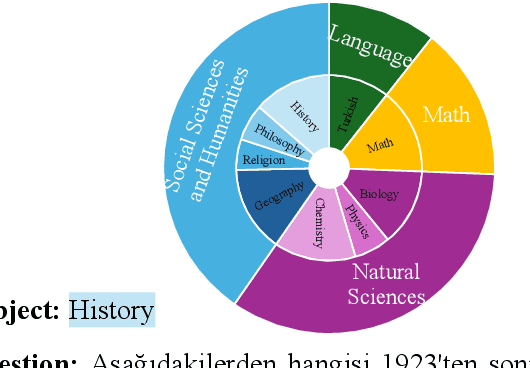
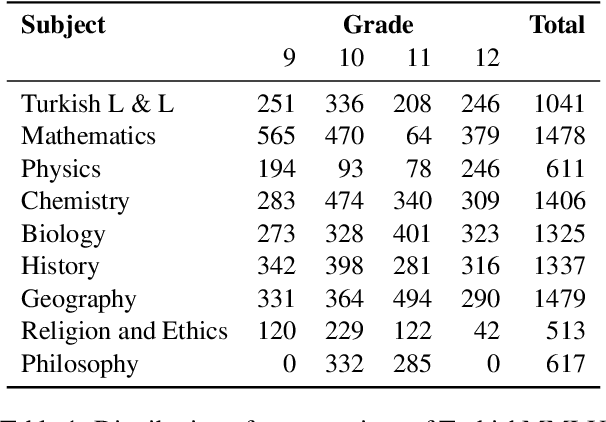
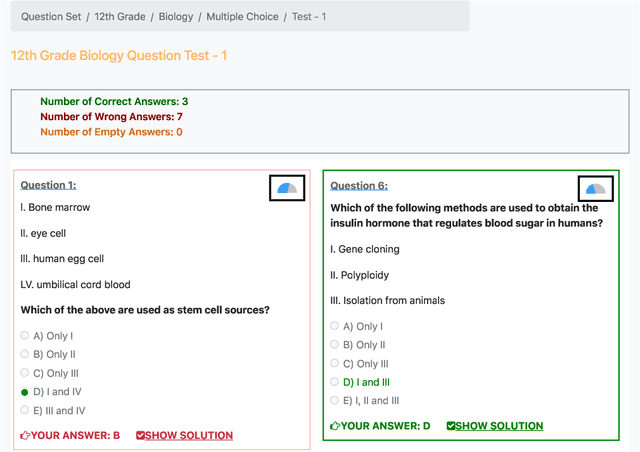
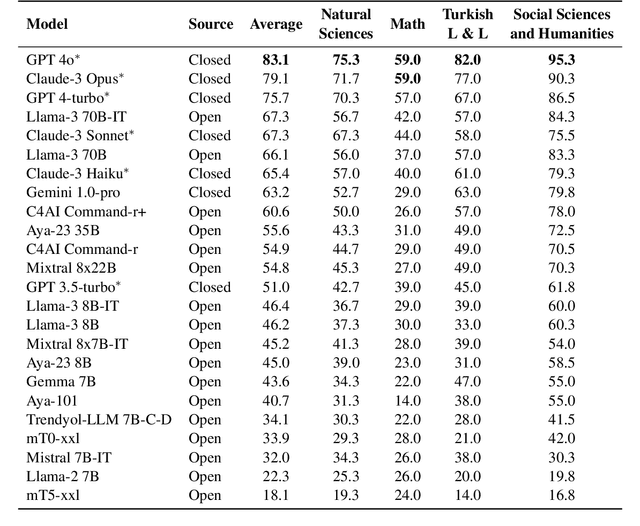
Abstract:Multiple choice question answering tasks evaluate the reasoning, comprehension, and mathematical abilities of Large Language Models (LLMs). While existing benchmarks employ automatic translation for multilingual evaluation, this approach is error-prone and potentially introduces culturally biased questions, especially in social sciences. We introduce the first multitask, multiple-choice Turkish QA benchmark, TurkishMMLU, to evaluate LLMs' understanding of the Turkish language. TurkishMMLU includes over 10,000 questions, covering 9 different subjects from Turkish high-school education curricula. These questions are written by curriculum experts, suitable for the high-school curricula in Turkey, covering subjects ranging from natural sciences and math questions to more culturally representative topics such as Turkish Literature and the history of the Turkish Republic. We evaluate over 20 LLMs, including multilingual open-source (e.g., Gemma, Llama, MT5), closed-source (GPT 4o, Claude, Gemini), and Turkish-adapted (e.g., Trendyol) models. We provide an extensive evaluation, including zero-shot and few-shot evaluation of LLMs, chain-of-thought reasoning, and question difficulty analysis along with model performance. We provide an in-depth analysis of the Turkish capabilities and limitations of current LLMs to provide insights for future LLMs for the Turkish language. We publicly release our code for the dataset and evaluation: https://github.com/ArdaYueksel/TurkishMMLU.
"Seeing the Big through the Small": Can LLMs Approximate Human Judgment Distributions on NLI from a Few Explanations?
Jun 25, 2024Abstract:Human label variation (HLV) is a valuable source of information that arises when multiple human annotators provide different labels for valid reasons. In Natural Language Inference (NLI) earlier approaches to capturing HLV involve either collecting annotations from many crowd workers to represent human judgment distribution (HJD) or use expert linguists to provide detailed explanations for their chosen labels. While the former method provides denser HJD information, obtaining it is resource-intensive. In contrast, the latter offers richer textual information but it is challenging to scale up to many human judges. Besides, large language models (LLMs) are increasingly used as evaluators (``LLM judges'') but with mixed results, and few works aim to study HJDs. This study proposes to exploit LLMs to approximate HJDs using a small number of expert labels and explanations. Our experiments show that a few explanations significantly improve LLMs' ability to approximate HJDs with and without explicit labels, thereby providing a solution to scale up annotations for HJD. However, fine-tuning smaller soft-label aware models with the LLM-generated model judgment distributions (MJDs) presents partially inconsistent results: while similar in distance, their resulting fine-tuned models and visualized distributions differ substantially. We show the importance of complementing instance-level distance measures with a global-level shape metric and visualization to more effectively evaluate MJDs against human judgment distributions.
Fairer Preferences Elicit Improved Human-Aligned Large Language Model Judgments
Jun 17, 2024Abstract:Large language models (LLMs) have shown promising abilities as cost-effective and reference-free evaluators for assessing language generation quality. In particular, pairwise LLM evaluators, which compare two generated texts and determine the preferred one, have been employed in a wide range of applications. However, LLMs exhibit preference biases and worrying sensitivity to prompt designs. In this work, we first reveal that the predictive preference of LLMs can be highly brittle and skewed, even with semantically equivalent instructions. We find that fairer predictive preferences from LLMs consistently lead to judgments that are better aligned with humans. Motivated by this phenomenon, we propose an automatic Zero-shot Evaluation-oriented Prompt Optimization framework, ZEPO, which aims to produce fairer preference decisions and improve the alignment of LLM evaluators with human judgments. To this end, we propose a zero-shot learning objective based on the preference decision fairness. ZEPO demonstrates substantial performance improvements over state-of-the-art LLM evaluators, without requiring labeled data, on representative meta-evaluation benchmarks. Our findings underscore the critical correlation between preference fairness and human alignment, positioning ZEPO as an efficient prompt optimizer for bridging the gap between LLM evaluators and human judgments.
Culturally Aware and Adapted NLP: A Taxonomy and a Survey of the State of the Art
Jun 06, 2024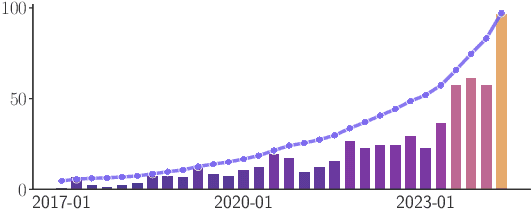
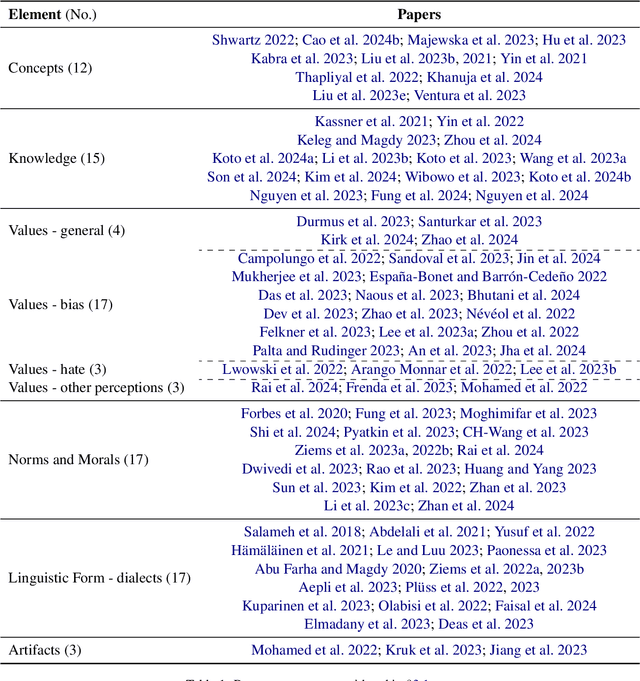

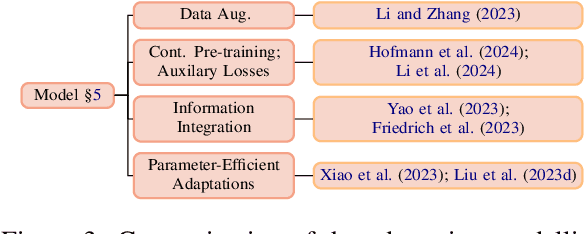
Abstract:The surge of interest in culturally aware and adapted Natural Language Processing (NLP) has inspired much recent research. However, the lack of common understanding of the concept of "culture" has made it difficult to evaluate progress in this emerging area. Drawing on prior research in NLP and related fields, we propose an extensive taxonomy of elements of culture that can provide a systematic framework for analyzing and understanding research progress. Using the taxonomy, we survey existing resources and models for culturally aware and adapted NLP, providing an overview of the state of the art and the research gaps that still need to be filled.
TopViewRS: Vision-Language Models as Top-View Spatial Reasoners
Jun 04, 2024



Abstract:Top-view perspective denotes a typical way in which humans read and reason over different types of maps, and it is vital for localization and navigation of humans as well as of `non-human' agents, such as the ones backed by large Vision-Language Models (VLMs). Nonetheless, spatial reasoning capabilities of modern VLMs remain unattested and underexplored. In this work, we thus study their capability to understand and reason over spatial relations from the top view. The focus on top view also enables controlled evaluations at different granularity of spatial reasoning; we clearly disentangle different abilities (e.g., recognizing particular objects versus understanding their relative positions). We introduce the TopViewRS (Top-View Reasoning in Space) dataset, consisting of 11,384 multiple-choice questions with either realistic or semantic top-view map as visual input. We then use it to study and evaluate VLMs across 4 perception and reasoning tasks with different levels of complexity. Evaluation of 10 representative open- and closed-source VLMs reveals the gap of more than 50% compared to average human performance, and it is even lower than the random baseline in some cases. Although additional experiments show that Chain-of-Thought reasoning can boost model capabilities by 5.82% on average, the overall performance of VLMs remains limited. Our findings underscore the critical need for enhanced model capability in top-view spatial reasoning and set a foundation for further research towards human-level proficiency of VLMs in real-world multimodal tasks.
 Add to Chrome
Add to Chrome Add to Firefox
Add to Firefox Add to Edge
Add to Edge